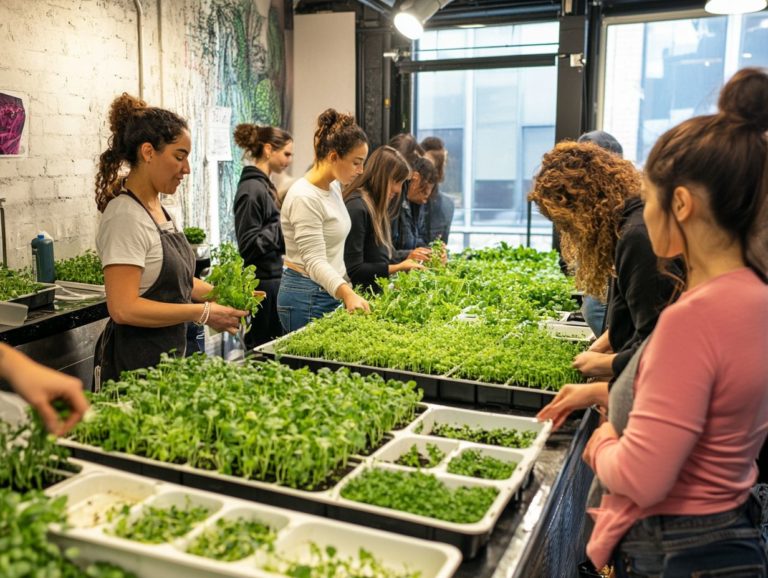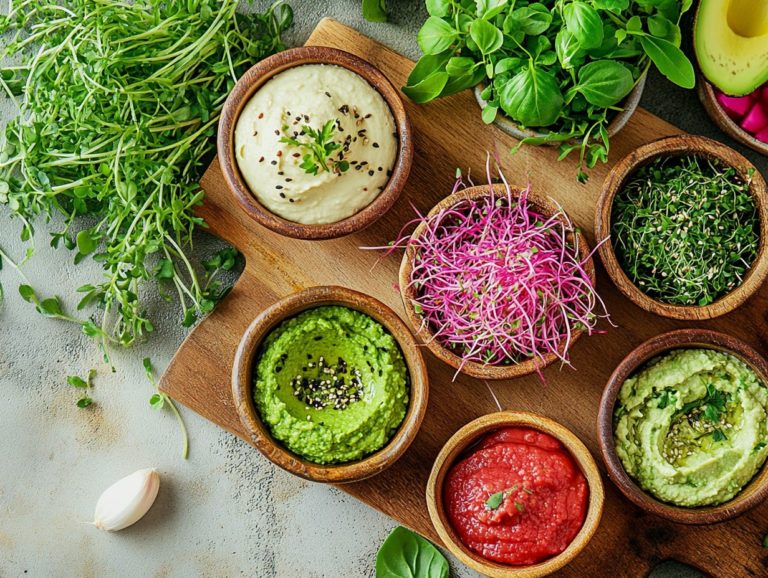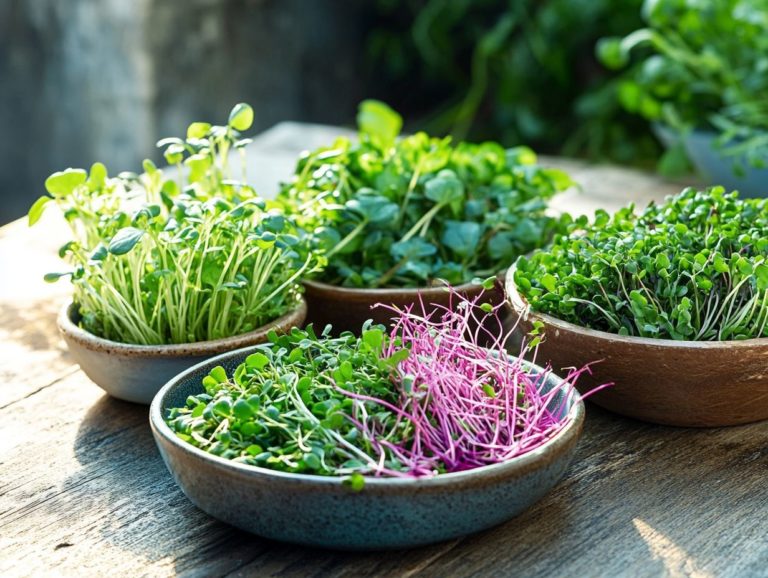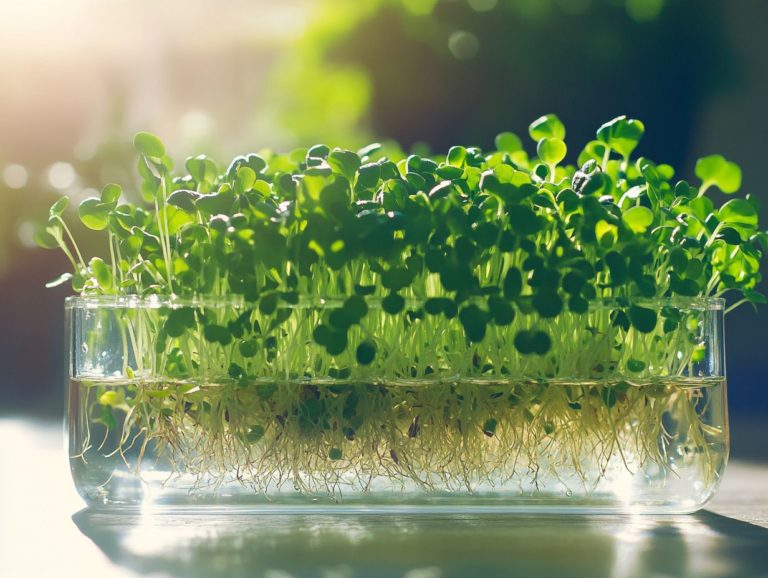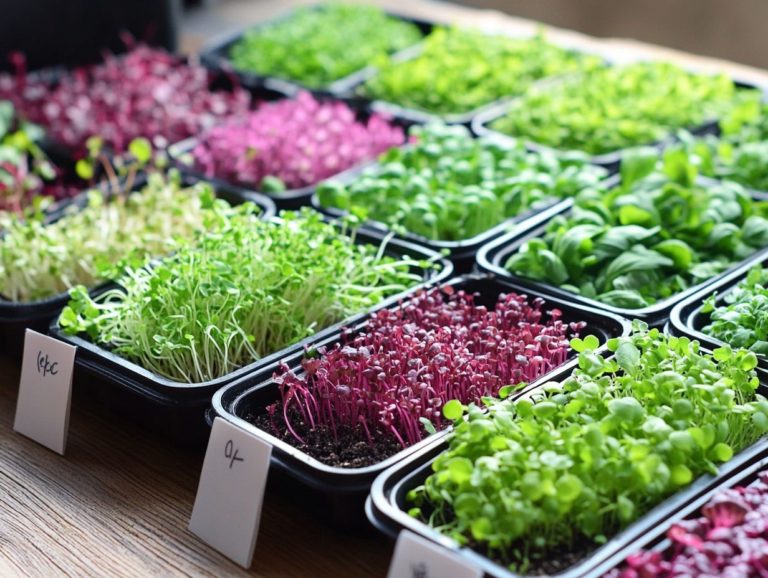What Are the Common Mistakes in Growing Microgreens?
Microgreens have surged in popularity within the culinary realm, celebrated for their vibrant colors, bold flavors, and remarkable nutritional advantages.
Whether you re a seasoned gardener or a newcomer eager to introduce a touch of greenery into your home, growing microgreens can be both rewarding and enjoyable. Like any gardening pursuit, it presents its own set of challenges. Let s explore the common pitfalls many encounter when growing microgreens, including slow germination and uneven growth. We will also provide practical strategies for successful cultivation and underscore their extraordinary benefits.
Prepare to nurture your green thumb and elevate your gardening game!
Contents
Key Takeaways:
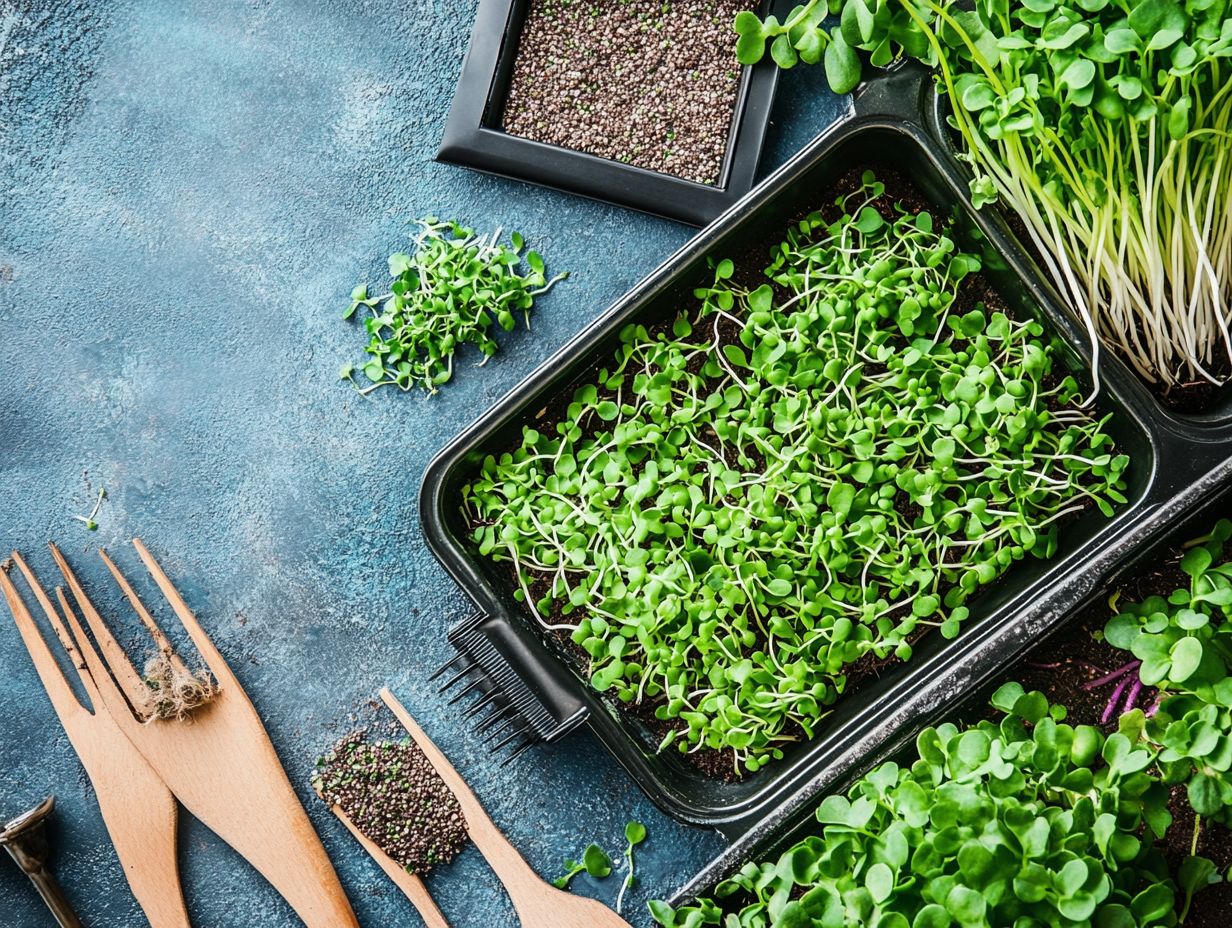
- Overwatering and underwatering are common mistakes in growing microgreens that can lead to mold growth or stunted growth.
- Proper lighting and temperature are crucial for successful microgreen growth. Consider using grow lights and maintaining a temperature range of 60-75 F.
- Choosing the right seeds and varieties, proper watering and light exposure, and knowing when and how to harvest and store microgreens are key tips for successful microgreen growth.
What are Microgreens?
Microgreens are young, edible plants that you can harvest just after their first true leaves make an appearance, typically within 7 to 21 days of germination. They are full of nutrients and vibrant flavors, making them an ideal choice for those who are health-conscious or have a flair for culinary creativity.
These miniature powerhouses pack higher nutrient densities than their fully grown counterparts, offering a rich source of vitamins, minerals, and antioxidants, particularly from varieties like broccoli and basil, that can elevate any meal. You can use them in many ways, ranging from garnishing salads to enhancing sandwiches and entrees, all thanks to their peppery, fresh, or subtly sweet flavors.
Among the most sought-after varieties are:
- Radish
- Cilantro
- Sunflower
Each of these provides unique taste profiles and health benefits. To successfully cultivate microgreens, you ll need to grasp the intricacies of photosynthesis, which is how plants make food using light. Ensure adequate light exposure and maintain appropriate humidity. You also need the right watering and lighting techniques to encourage strong roots, including healthy root hairs.
Exploring the art of growing microgreens not only enriches your diet but also promotes sustainable, home-grown food choices.
Benefits of Growing Microgreens
Growing microgreens offers amazing benefits you can t miss, from their exceptional nutritional value to the ease with which they can be cultivated. These tiny powerhouses pack vitamins, minerals, and antioxidants, making them a true superfood that can enhance your overall health.
Their adaptability allows you to grow them in small spaces, whether indoors or outdoors, requiring minimal equipment and a mere few weeks before you can harvest. This accessibility gives everyone from urban dwellers to beginners and seasoned gardening aficionados the power to seamlessly incorporate fresh produce into their diets, fostering healthier eating habits and a more sustainable lifestyle, while minimizing mold growth.
Start growing today and enjoy the health benefits!
Nutritional Value and Easy Cultivation
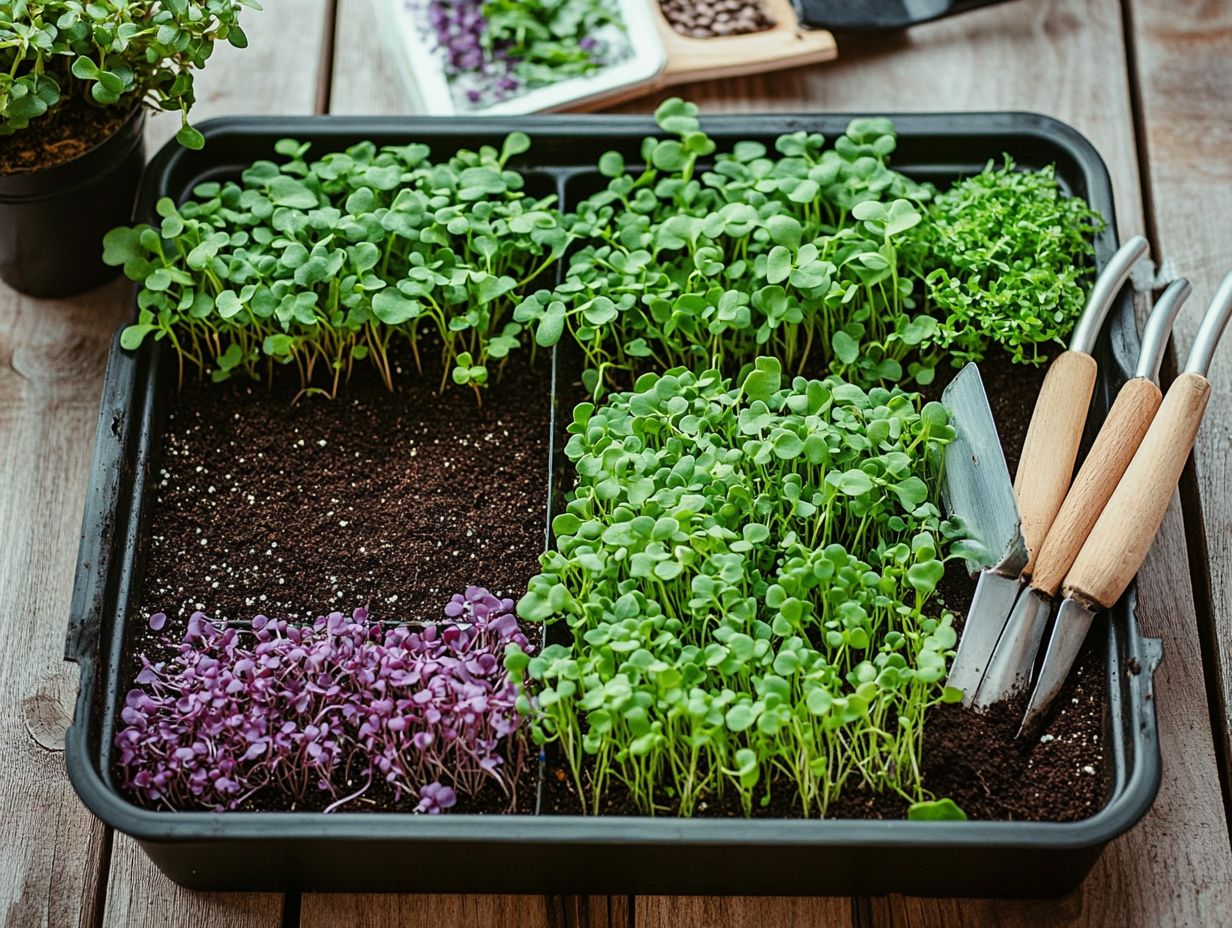
Microgreens are celebrated for their exceptional nutritional value. They offer a concentrated source of vitamins and minerals in a compact form. In fact, they often boast higher nutrient levels than their mature counterparts. This is especially true for varieties like broccoli and basil, along with amaranth, which not only flourish with minimal effort but also deliver rich flavors that elevate your culinary creations.
Cultivating microgreens is straightforward and accessible; they require little space and resources. This makes them perfect for urban gardeners and anyone eager to enrich their diets with fresh produce. The rapid growth cycle allows for multiple harvests throughout the year. This ensures a steady supply of these nutritious greens.
These petite plants are brimming with vitamins such as A, C, E, and K, along with essential minerals like iron and magnesium. All of which can significantly enhance your balanced diet. Remarkably, microgreens can be up to 40 times more nutritious per serving compared to fully grown plants.
To ensure they thrive, selecting the appropriate soil is essential. A lightweight seed-starting mix typically yields the best results. Regular watering is crucial, but be careful not to overdo it. Excess moisture can lead to mold and harmful fungus. Ideally, these greens should bask in plenty of light either natural sunlight or artificial lights that help plants grow indoors for about 12 to 16 hours a day. This will achieve that vibrant green hue and robust flavor you desire.
Common Mistakes in Growing Microgreens
Growing microgreens can be incredibly rewarding, but it’s essential to recognize the common mistakes that can impede your success. Issues such as uneven growth and slow germination can arise.
Many newcomers may not realize that overwatering is a common pitfall. It creates a humid environment that invites mold and fungus, putting your plants’ health at risk. This can lead to slow germination. The quality of your seeds matters. Low-quality seed packets can lead to disappointing results and weak plants.
By understanding these common errors and applying the right techniques, you can elevate your gardening experience significantly.
Overwatering and Underwatering
Overwatering and underwatering are among the most common challenges you ll face while growing microgreens. Each poses serious risks to plant health. When you overwater, you create a humid paradise for mold and fungus. On the other hand, underwatering can put the brakes on germination and stunt growth.
Establishing a balanced watering routine is essential. Using effective water circulation methods ensures your growing medium stays moist but never waterlogged. By understanding the specific water needs of each microgreen variety, you can refine your cultivation practices and cultivate healthy, vibrant plants.
Recognizing the signs of overwatering like yellowing leaves or a sour odor can be a lifesaver for your plants, preventing further decline. If your seedlings are looking wilted or crispy, especially during the blackout period after planting, it’s an unmistakable cue that they re not getting enough moisture.
You can employ drip irrigation systems or opt for spray bottles to provide gentle hydration, making sure each microgreen gets the moisture it craves.
Keeping humidity levels between 40-60% is ideal for boosting growth rates at various stages. Simple tactics, such as using humidity domes or misting, can effortlessly create the perfect conditions for optimal airflow, setting the stage for flourishing microgreens.
Don’t miss out on this wonderful opportunity to grow your own greens! Start your microgreen journey today for a healthier lifestyle!
Improper Lighting and Temperature
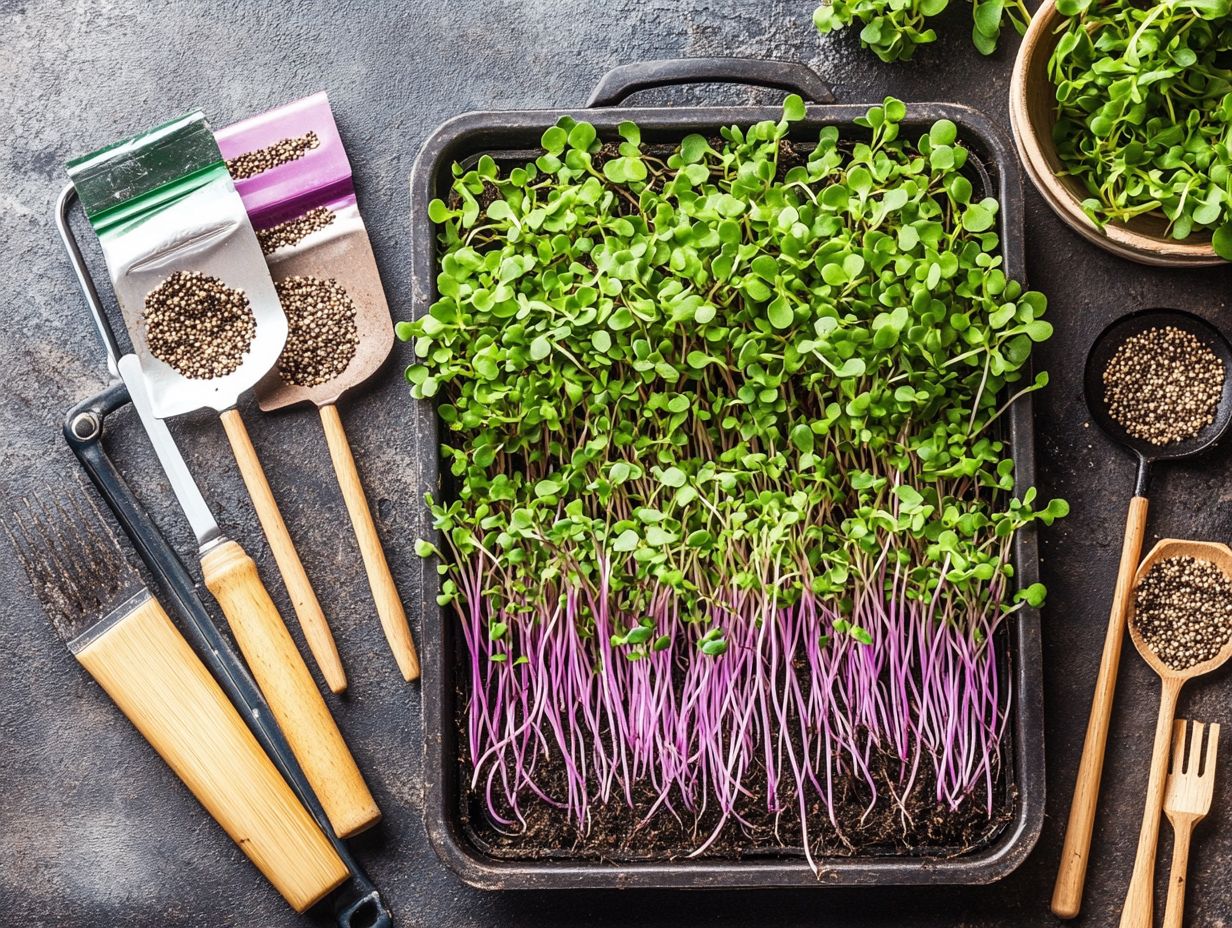
Improper lighting and temperature can truly hinder the growth of your microgreens, leading to uneven development and weak plants. Microgreens flourish best under specific conditions, which include ample light exposure essential for photosynthesis and overall vitality.
Temperature fluctuations can affect how quickly seeds germinate. If it s too cold or too hot, you risk slowing the process or even losing seedlings. Cultivating an environment with consistent light and temperature levels is crucial. Get the right lighting, like grow lights from Mars Hydro or AllThatGrows, to achieve optimal results.
Aim for about 12 to 16 hours of light each day to simulate natural sunlight, while keeping temperatures between 65 F to 75 F for most varieties. Overlooking these factors may result in leggy growth, as your plants stretch desperately for light. To debunk common misconceptions, check out what are the microgreen growing myths. Excessive heat can also promote mold growth, severely compromising the quality of your microgreens.
By ensuring the right lighting and temperature, along with adequate ventilation, you not only enhance their visual appeal but also boost their nutrient content, making them tastier and healthier. Start applying these tips today for a flourishing microgreen garden!
Choose the Right Soil and Containers for Thriving Microgreens!
Using the wrong soil and containers can significantly impact your microgreen growth. This can lead to poor seed quality and lackluster root development. A clean growing medium is essential for growing healthy microgreens. Options such as coconut coir made from the husks of coconuts provide excellent drainage and aeration.
Select clean trays that facilitate proper water circulation and airflow to avoid stagnant conditions that attract mold and fungus. By grasping these critical elements, you can create an optimal environment for your microgreens.
For the best results, consider lightweight materials for easy handling and watering. Your containers should ideally have drainage holes to remove excess water, minimizing the risk of rot.
Don t underestimate the importance of disinfecting your equipment before use. This simple step greatly reduces the chances of disease infiltrating your growing space. Opt for biodegradable options and use coconut coir to support sustainability while enriching the soil as they break down, contributing further to your plants’ nutrition.
By paying attention to these factors, you can elevate your growth conditions, resulting in vibrant and flavorful microgreens.
Tips for Successful Microgreen Growth
For successful microgreen growth, implementing effective strategies is crucial. Begin with proper watering techniques to keep the soil moisture just right enough to nourish without causing over-saturation.
Ensure optimal light exposure to boost photosynthesis, allowing your microgreens to thrive. Choosing high-quality seeds will set you on the path to strong germination and healthy plants.
Don t overlook ventilation; maintaining good airflow is essential to prevent excessive humidity and promote robust growth. By following these guidelines, you ll be well on your way to a bountiful harvest of microgreens that elevate both your meals and overall wellness.
Unlock Success with the Right Seeds!
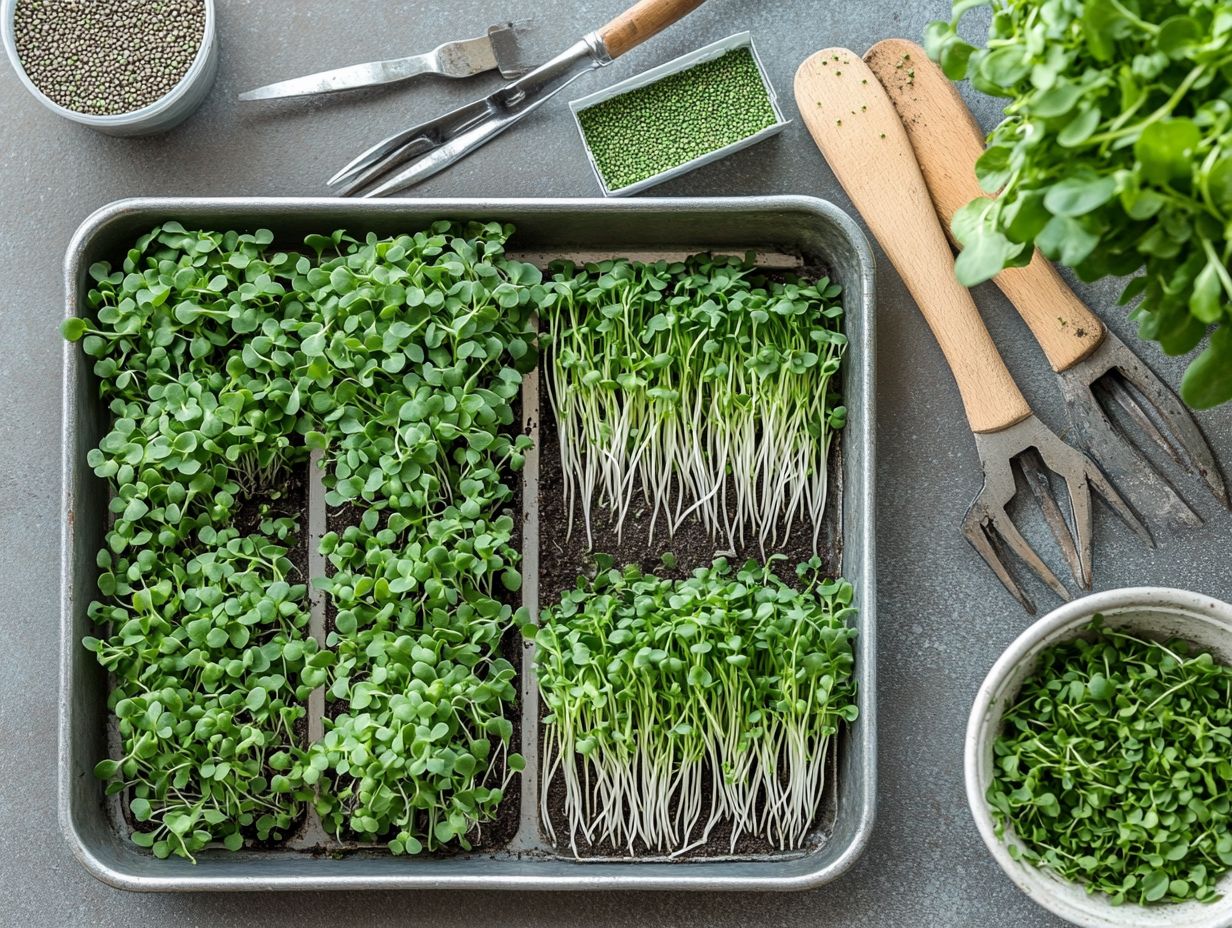
Choosing the right seeds and varieties is essential for your success in microgreen cultivation. The quality of the seeds you select directly affects germination rates the speed at which seeds sprout and the overall health of your plants.
Popular microgreens, like heirloom seeds of broccoli, basil, and amaranth, not only offer unique flavors but also provide nutritional benefits, making them fantastic options for both novice and seasoned growers.
When selecting seeds, choose reputable sources to ensure high germination rates and robust plant development. Knowing each variety’s characteristics helps you choose the best seeds to match your culinary preferences and growing conditions.
Consider factors such as seed size, growth rate, and flavor profiles to guide your choices. If you’re eager for quick results, fast-growing varieties like radish and mustard are perfect. Flavorful herbs like cilantro and dill can elevate your dishes with their vibrant tastes.
The adaptability of microgreens makes them suitable for various environments, whether you have limited indoor space or a sunny patio. Being mindful of these elements enhances your growing experience and fosters a deeper appreciation for the diverse world of microgreens.
Boost Your Microgreens with Perfect Watering and Light!
Proper watering and light exposure are essential elements in successfully cultivating microgreens. They directly impact their growth, flavor, and nutritional value.
To enhance your success, implement specific watering techniques, such as top watering with a gentle spray or using a misting bottle. These methods help evenly distribute moisture without disturbing delicate seedlings. Check the moisture level daily and adjust your watering schedule as needed, especially during the warmer months.
For lighting, use full-spectrum LED grow lights providing both blue and red wavelengths to significantly improve photosynthesis. A recommended routine involves 12-16 hours of light daily, mimicking natural sunlight to ensure your microgreens develop optimal vigor and flavor while avoiding the common pitfalls of stretching toward the light source.
Harvesting Microgreens: Timing is Everything!
Harvesting microgreens at the right moment and using proper storage techniques can elevate their flavor and shelf life. This ensures you make the most of your cultivation endeavors.
Aim to harvest your microgreens when they showcase their vibrant colors and reach about 1-3 inches in height for optimal freshness. Equip yourself with sharp, clean scissors or a razor blade for a precise cut just above the soil line, minimizing stress on the plants.
Once you ve made the cut, it s all about storage. Opt for breathable containers lined with paper towels to wick away excess moisture while still allowing for airflow. Proper refrigeration is key, ideally maintaining temperatures between 32 F to 40 F to significantly enhance their shelf life.
By mastering these techniques, you ll not only savor the vibrant flavors but also extend the delicious life of your microgreens. Start harvesting today and taste the difference!
Frequently Asked Questions
Got questions? We’ve got answers!
What are the common mistakes in growing microgreens?
1. Overwatering: Don t let overwatering ruin your microgreens! This mistake can waterlog the roots, leading to rot and plant death.
2. Using poor quality soil: Microgreens thrive in nutrient-rich soil. Poor quality soil leads to stunted or unhealthy plants.
3. Not enough light: Microgreens need plenty of light to grow strong. Without enough light, they become leggy and weak.
4. Incorrect seed density: Planting the right amount of seeds makes a difference in growth. Follow the recommended seed density for your microgreens.
5. Improper ventilation: Poor air circulation encourages mold and fungus. Ensure proper ventilation to keep your microgreens healthy.
6. Not harvesting at the right time: Timing is everything! Harvest microgreens at their peak for the best flavor and nutrition.


